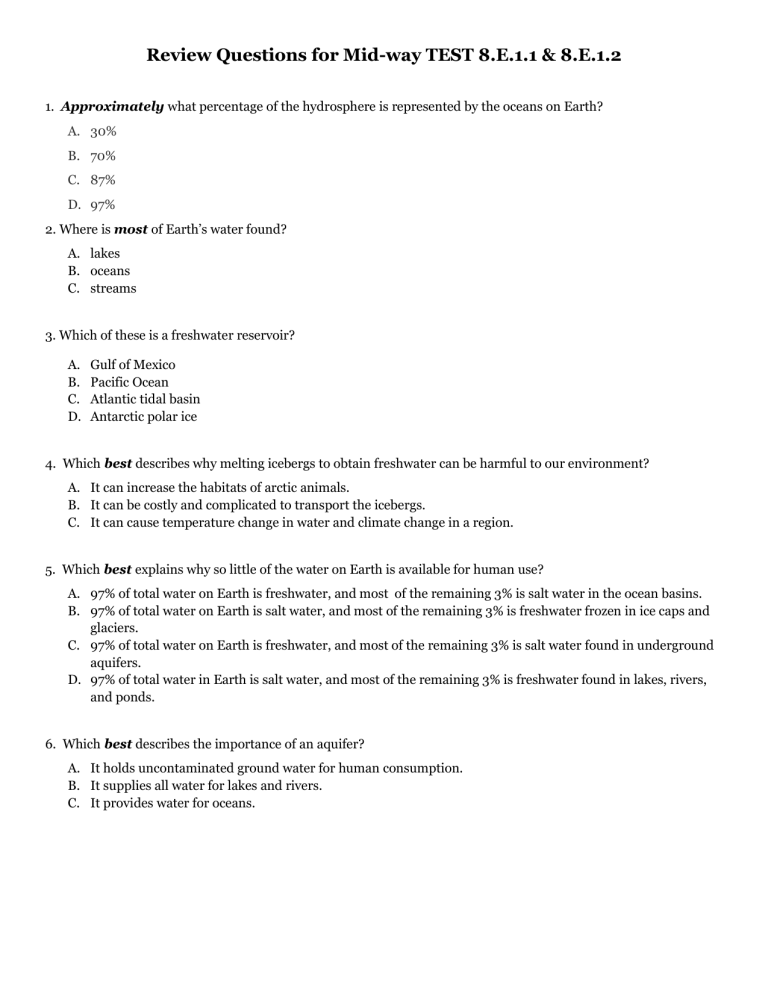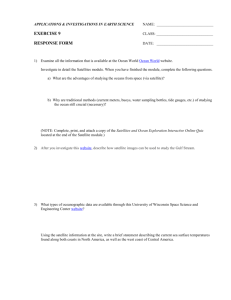Review Questions for Mid-way TEST 8

Review Questions for Mid-way TEST 8.E.1.1 & 8.E.1.2
1. Approximately what percentage of the hydrosphere is represented by the oceans on Earth?
A.
30%
B.
70%
C.
87%
D.
97%
2. Where is most of Earth’s water found?
A.
lakes
B.
oceans
C.
streams
3. Which of these is a freshwater reservoir?
A.
Gulf of Mexico
B.
Pacific Ocean
C.
Atlantic tidal basin
D.
Antarctic polar ice
4. Which best describes why melting icebergs to obtain freshwater can be harmful to our environment?
A.
It can increase the habitats of arctic animals.
B.
It can be costly and complicated to transport the icebergs.
C.
It can cause temperature change in water and climate change in a region.
5. Which best explains why so little of the water on Earth is available for human use?
A.
97% of total water on Earth is freshwater, and most of the remaining 3% is salt water in the ocean basins.
B.
97% of total water on Earth is salt water, and most of the remaining 3% is freshwater frozen in ice caps and glaciers.
C.
97% of total water on Earth is freshwater, and most of the remaining 3% is salt water found in underground aquifers.
D.
97% of total water in Earth is salt water, and most of the remaining 3% is freshwater found in lakes, rivers, and ponds.
6. Which best describes the importance of an aquifer?
A.
It holds uncontaminated ground water for human consumption.
B.
It supplies all water for lakes and rivers.
C.
It provides water for oceans.
7. Which statement best compares the amount of water present on Earth today with the amount present millions of years ago?
A.
There is slightly more water on Earth today.
B.
There is significantly less water on Earth today.
C.
There is significantly more water on Earth today.
D.
There is about the same amount of water on Earth today.
8. Which best describes the world’s oceans?
A.
There is one ocean with one basin.
B.
There is one ocean with many basins.
C.
There are many oceans with one basin.
9. Which natural feature protects inland bodies of water from contamination by salt water?
A.
bog
B.
canyon
C.
estuary
D.
hydrothermal vent
10. Why are upwellings in the ocean essential for some organisms to survive?
A.
because many animals need low-tide conditions each day
B.
because currents carry predators away from the surface
C.
because the warm water kills bacteria before it can harm plankton
D.
because needed nutrients and dissolved gasses are brought into new areas
11. Which best describes the types of organisms found in estuaries?
A.
They can survive in salt water.
B.
They are only found in freshwater.
C.
They cannot tolerate brackish water.
D.
They tolerate both freshwater and salt water.
12. Which characteristic of an estuary makes it a good nursery area for marine organisms?
A.
It is located at the mouth of a river.
B.
It has a mix of salt and fresh water.
C.
It has many areas to hide from predators.
D.
It has the ability to absorb water and prevent flooding.
13. Which is least often used to study the deepest parts of the ocean floor?
A.
sonar
B.
satellites
C.
scuba divers
D.
submersibles
14. Why do large numbers of ocean life-forms live near areas of upwelling?
A.
Upwelling brings nutrients to the surface.
B.
Upwelling brings warm water to the surface.
C.
Upwelling helps push small fish up toward the surface.
D.
Upwelling keeps large predator fish away from the surface.
15. Why are many fishing boats found near ocean upwellings?
A.
There is less vegetation there.
B.
The water is less turbulent there.
C.
Many marine species gather there to eat the nutrients brought to the surface.
D.
Upwellings are found in more shallow waters. so boats do not need deep anchorage.
16. Deep ocean technology has discovered organisms in hydrothermal vents that do not rely on sunlight to survive.
What do these organisms use as their energy source?
A.
chemosynthesis
B.
electrical charge
C.
hydropower
D.
thermal heat
17.
Which statement about ocean currents is accurate?
A. Ocean currents influence life at the shore.
B. Ocean currents keep the ocean temperature unstable.
C. Ocean currents are a major cause of glacier formation.
D. Ocean currents stir nutrients to help in the production of oxygen.
18.
How does sonar technology help scientists monitor the hydrosphere?
A.
Sonar distributes satellite images for data collection.
B.
Sonar collects information from freshwater organisms.
C.
Sonar determines different levels of water quality in rivers.
D.
Sonar provides detailed images of small areas of the ocean floor.
19. The diagram below shows the zones of the ocean.
Which ocean zone contains hydrothermal vents?
A.
deep zone
B.
surface zone
C.
shallow zone
D.
intertidal zone
20.
Which river system moves the
A.
Nile River most freshwater on Earth?
B.
Volga River
C.
Amazon River
21.
Rivers and streams transport nutrients, salts, sediments, and pollutants.
Which is the correct order for this process?
A. estuaries → oceans → watersheds
B. watersheds → oceans → estuaries
C. watersheds → estuaries → oceans
22. A student is creating a model of a stream in a forested mountain watershed. Which of these features might be included in the model to show how the stream could overload with sediment?
A. a cabin near the stream
B. rocks in the middle of the stream
C. acres of cleared forest above the stream
D. grasses growing along the banks of the stream
23.
Where is the majority of Earth’s freshwater found?
A. polar ice caps
B. rivers
C. ponds
D. lakes
24.
What would most likely happen to the entire ocean food web if plankton were not available?
A.
All organisms that live in the ocean would not survive.
B.
The organisms would adapt and find another source of food.
C.
Only whales and other large ocean mammals would be affected.
25.
Which is true concerning the structure of the hydrosphere?
A.
There is one ocean with one basin.
B.
There are many oceans with many basins.
C.
The ocean is connected to many lakes, watersheds, and waterways.
26.
Why do plant plankton not grow in the deep ocean?
A. because sunlight does not reach the deep ocean
B. because too many animals eat it before it can grow
C. because there are not enough dissolved gases to support it
27.
Which most likely causes land that water drains into to form a watershed?
A.
The ground is saturated or permeable.
B.
The ground is saturated or impermeable.
C.
The ground is unsaturated or permeable.
28.
Which explains the true relationship between carbon dioxide in the atmosphere and the oceans?
A.
Ocean waters can hold small amounts of carbon dioxide.
B.
Cooler waters release excess carbon dioxide.
C.
Warmer waters release excess carbon dioxide.
29.
Which best describes the most abundant form of ocean life?
A. fish
B. algae
C. microbes
30.
Which is the
A.
Neritic largest zone in the ocean?
B.
Oceanic
C.
Intertidal
Answer Key:
1.
d
2.
b
3.
d
4.
c
5.
b
6.
a
7.
d
8.
b
9.
c
10.
d
11.
d
12.
c
13.
c
14.
a
15.
c
16.
a
17.
d
18.
d
19.
a
20.
c
21.
c
22.
c
23.
a
24.
a
25.
c
26.
a
27.
b
28.
c
29.
c
30.
b






